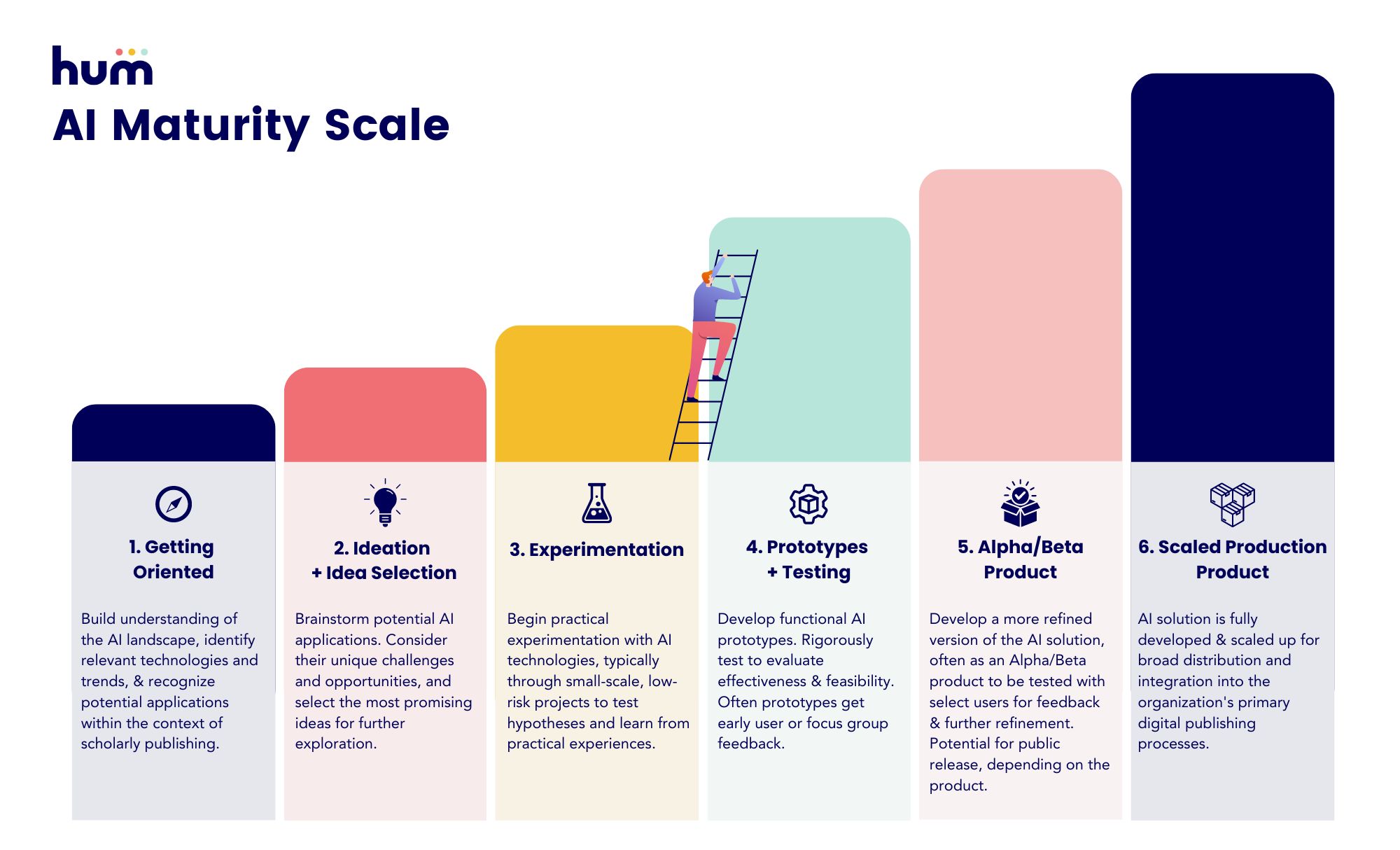Have you ever wondered how AI products get out into the world?
At the recent SSP 2024 Annual Meeting, Hum’s Co-founder and President, Dustin moderated a panel on the full lifecycle of developing and deploying innovative AI solutions and introduced the "AI Maturity Curve" – a framework outlining the key stages organizations go through when bringing an AI product to market:
- Getting Oriented: Building fundamental AI literacy and investigating use cases
- Ideation and Idea Selection: Generating ideas and pressure testing feasibility
- Experimentation: Quickly proving out concepts with models and data
- Prototypes and Testing: Developing minimum viable products and testing with users
- Alpha/Beta Product: Releasing a production-grade pilot version
- Scaled Production: Hardening the product for full rollout and adoption

As panelists Ann Michael (CTO, AIP Publishing), Max Gabriel (President, IIRIS at Informa), Julia McDonnell (Publishing Director for Owned Journals and Product, Oxford University Press) and Paul Gee (VP of Digital Product Management and Development, JAMA Network) illustrated with real case studies, there are no shortcuts. Moving AI innovations out into the world at scale requires dedicated investments of time, resources and commitment.
For scholarly publishers, the impetus to climb this curve is driven by both opportunity and necessity. AI represents a truly transformative force, enabling intelligent tools and capabilities that can create immense value. From accelerating research and discovery to automating mundane tasks and enhancing user experiences, AI opens up new avenues to augment every facet of the publishing value chain.
AI is a pathway to revitalize core offerings
The publishing industry is facing existential challenges from technological disruption and changing consumer behavior. Ann Michael's frank statement that "We don't deserve to exist as publishers" unless we continue innovating underscores this urgency. Publishers can no longer rely on their traditional roles as gatekeepers and distributors of content.
To remain relevant, publishers must find new ways to bring value to authors by helping them create better content more efficiently. This could mean providing AI writing assistants, automated metadata tagging, or content optimization tools. It also means enhancing the audience, delivering more personalized, engaging messaging and leveraging AI for recommendation engines, dynamic content generation, and enhanced search and discovery.
Ignoring these AI-driven opportunities puts publishers at risk of being disintermediated by newer, more nimble competitors. As Ann bluntly stated, audiences and authors don't owe publishers anything if they fail to evolve with technological change.
Blindly chasing AI is a fool’s errand
While AI presents many potential opportunities, Max Gabriel cautioned against adopting it purely for marketing buzzword reasons. Too often, the hype cycle around emerging technologies like AI causes companies to apply them in areas that don't make sense.
AI should only be utilized when it demonstrably excels at solving a particular problem. For many use cases, traditional software, process improvements, or human-driven approaches may still be more suitable.
His caution that AI is not a solution in search of problems serves as a reminder to thoroughly validate whether an AI solution is truly needed before investing resources into it. Just because AI is powerful doesn't mean it's the right solution for every problem a business faces. A rigorous product discovery process considering simpler alternatives is crucial.
AI disrupts previous technology shifts
Paul Gee highlighted how AI represents a fundamentally different type of technological disruption compared to previous shifts like the move from print to digital. In the past, organizations could more cleanly separate the application logic from the underlying data.
AI models intimately intertwine the training data and algorithms in a way that makes this separation untenable. Models effectively contain the data in their neurons (model weights) and use source material when they think through problems (in-context learning). This creates new strategic implications around data rights, model licensing, and governance that businesses must grapple with.
AI is not a distraction
Despite the complexities AI introduces, Julia McDonnell firmly rebutted the notion that AI is a distraction or passing fad for publishers. Those who ignore its disruptive potential risk obsolescence, while early movers can gain key competitive advantage.
AI demands the dedication of resources, focus, talent, processes, and change management in order to effectively capitalize on it. Treating it as less than a business-defining shift would be shortsighted.
"Publishers used to be able to be a fast follower to Elsevier. Elsevier would figure it out, then people would ultimately learn and copy. AI is different. I think we have a 18 month window to make meaningful progress. For those that don't, they're in real trouble."
- Big 10 Publishing Exec
We live in exciting times. Publishers have a short period of time to start climbing the AI Maturity Curve. For those that do, they’ll be able to build better experiences for readers, authors, editors, reviews and the entire publishing enterprise. And remain devoted to their mission for some time to come.